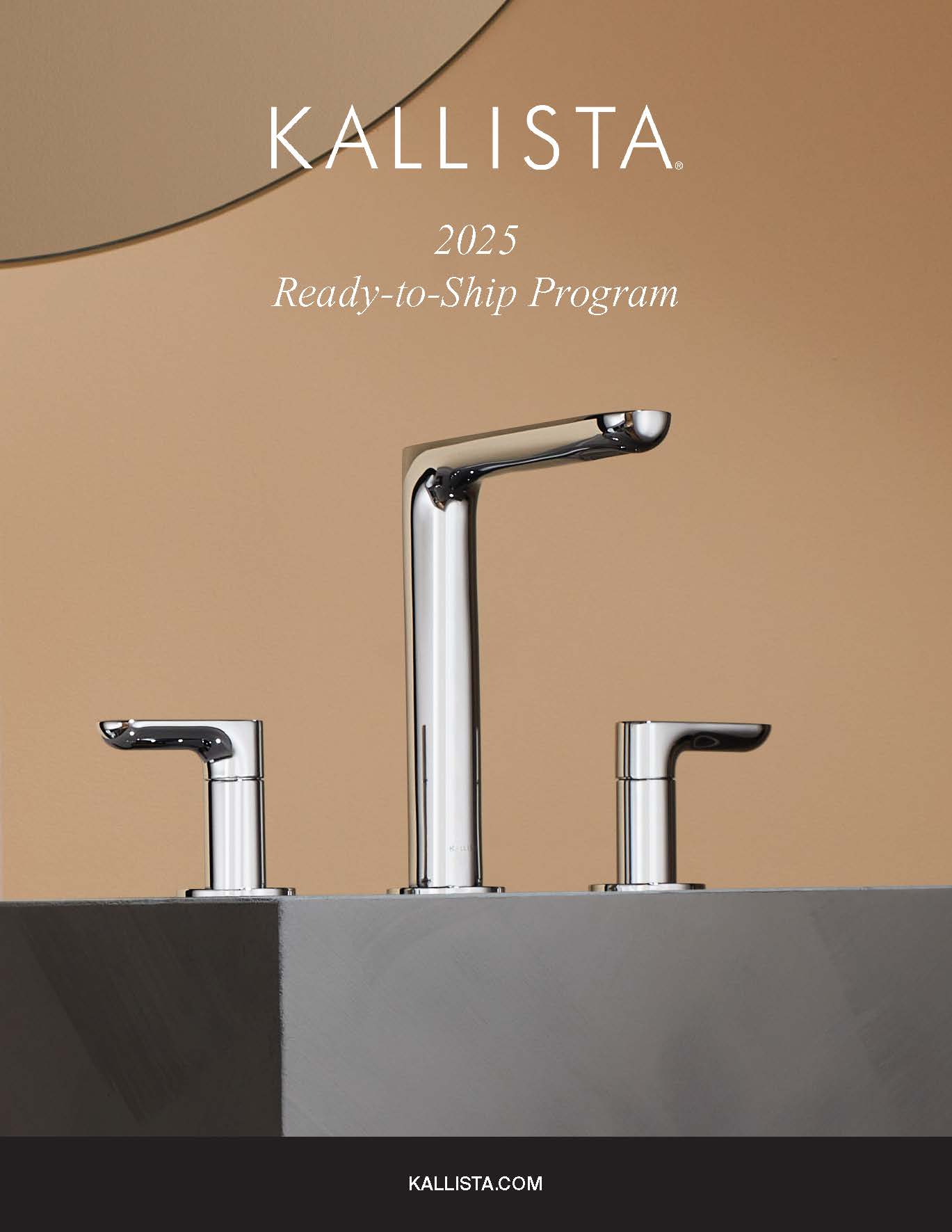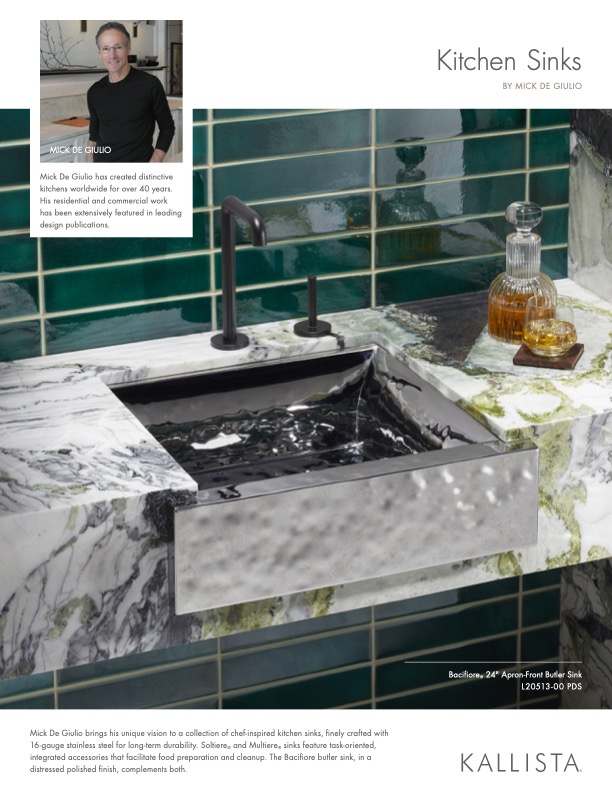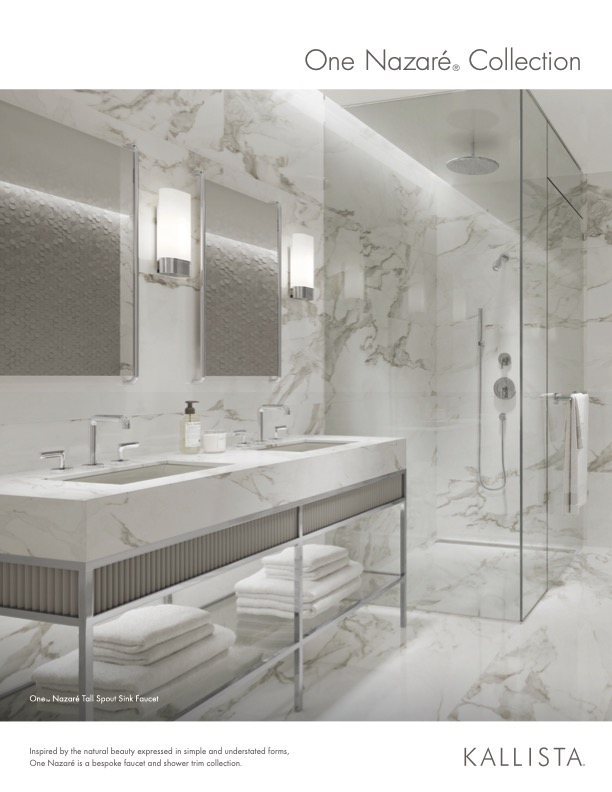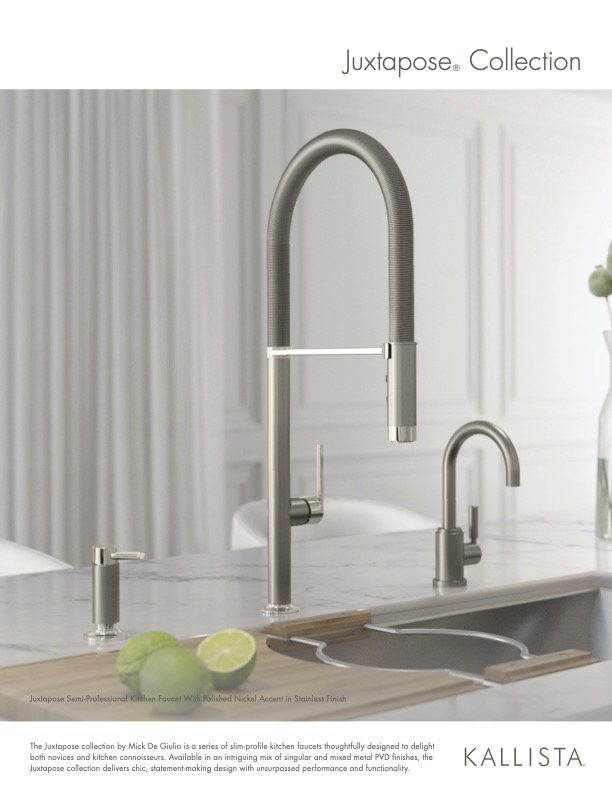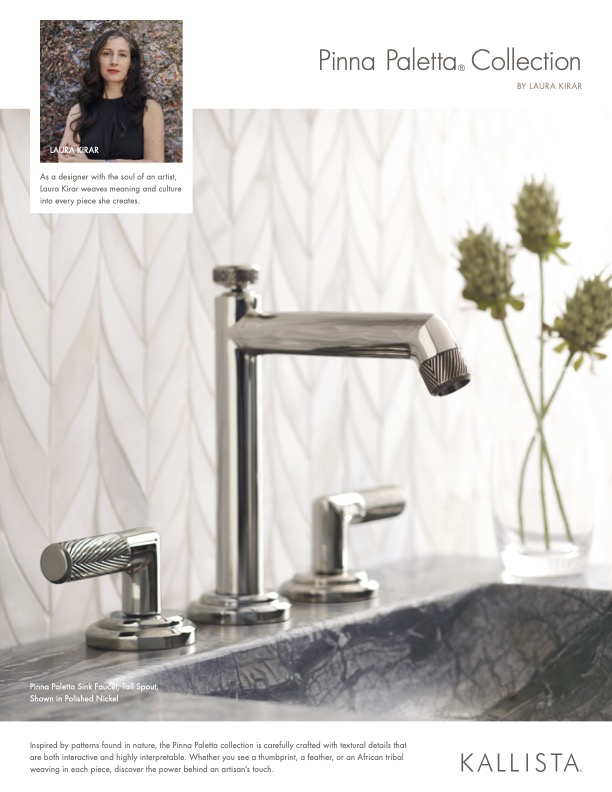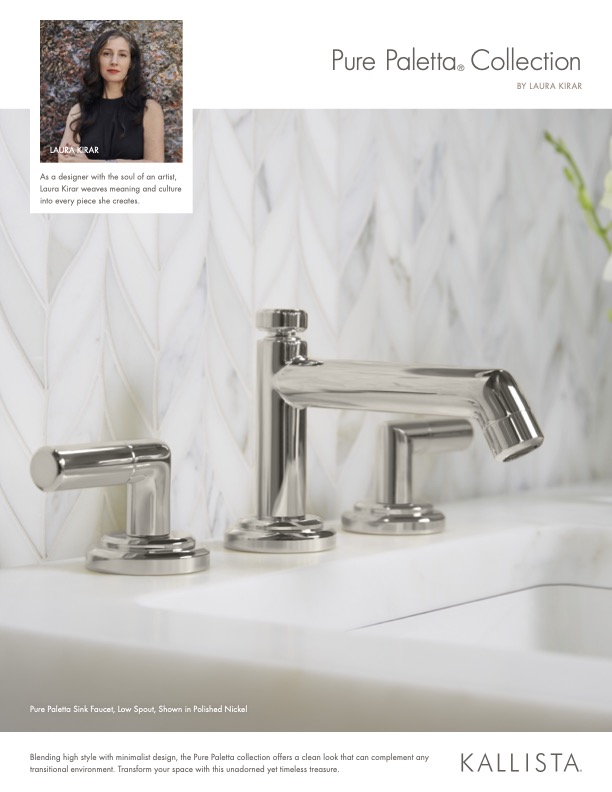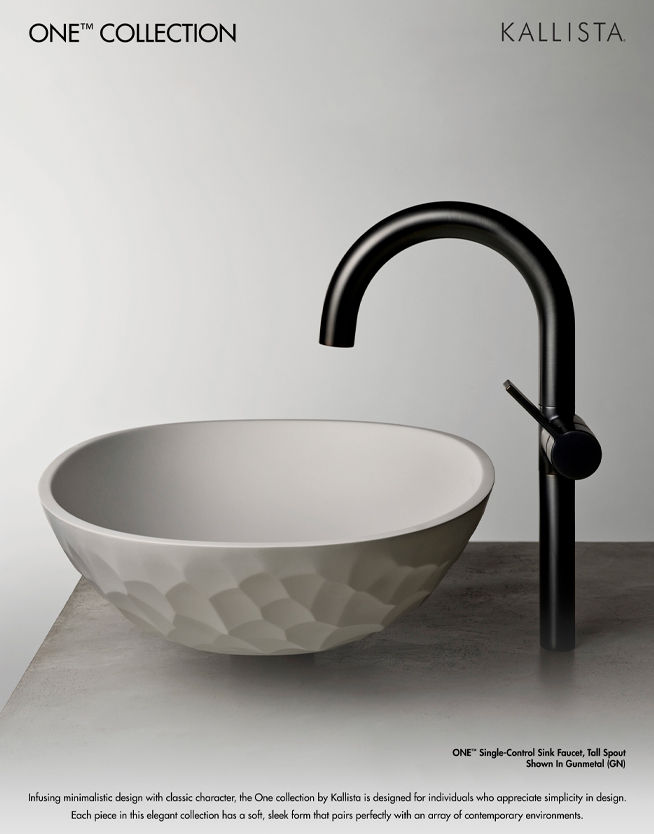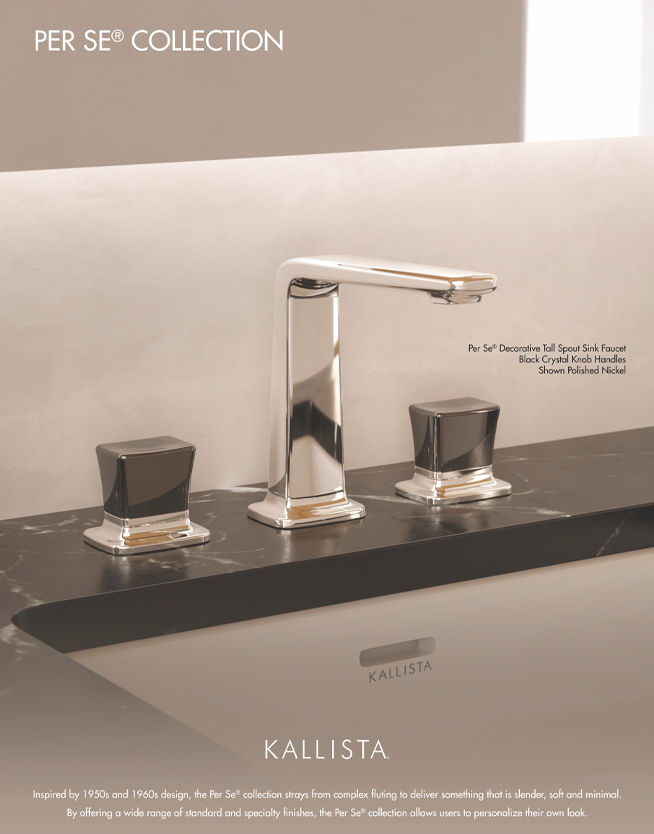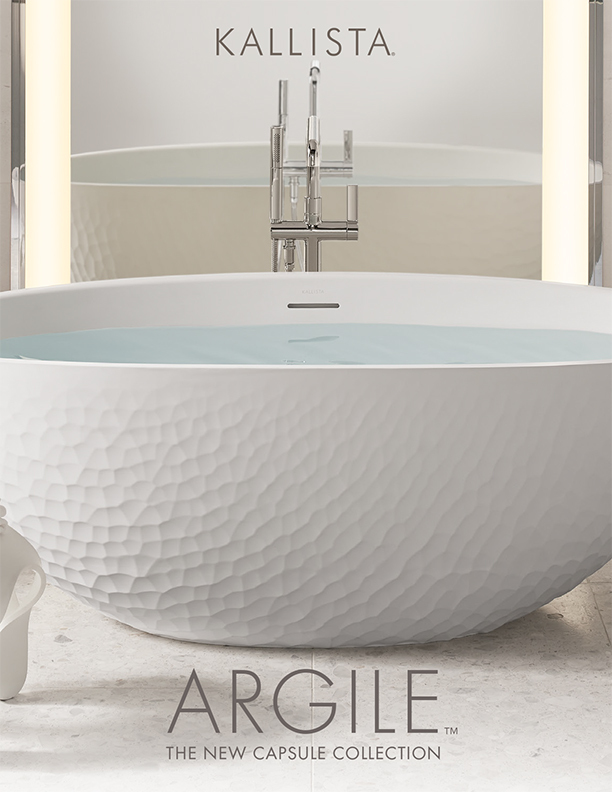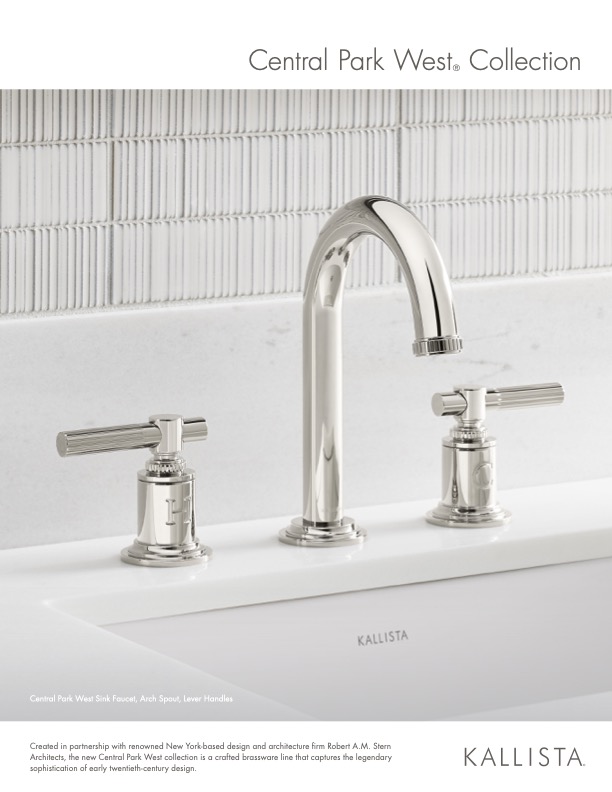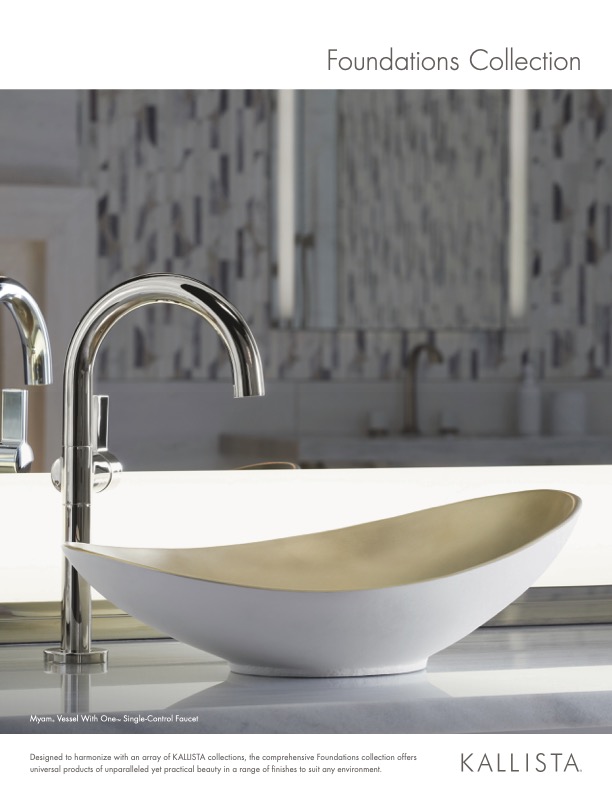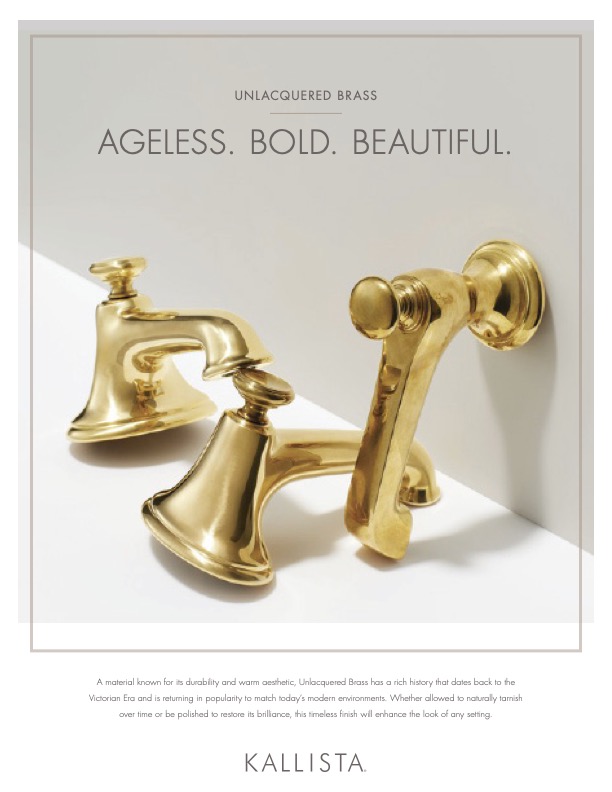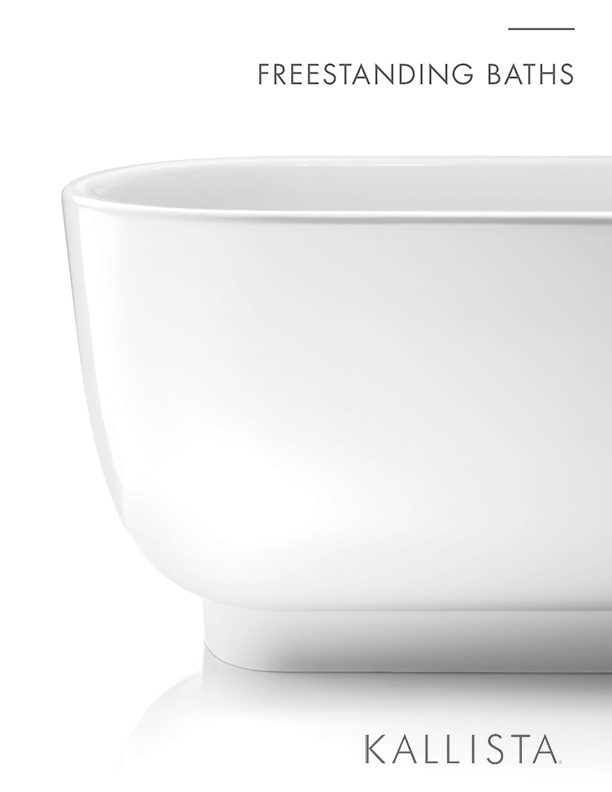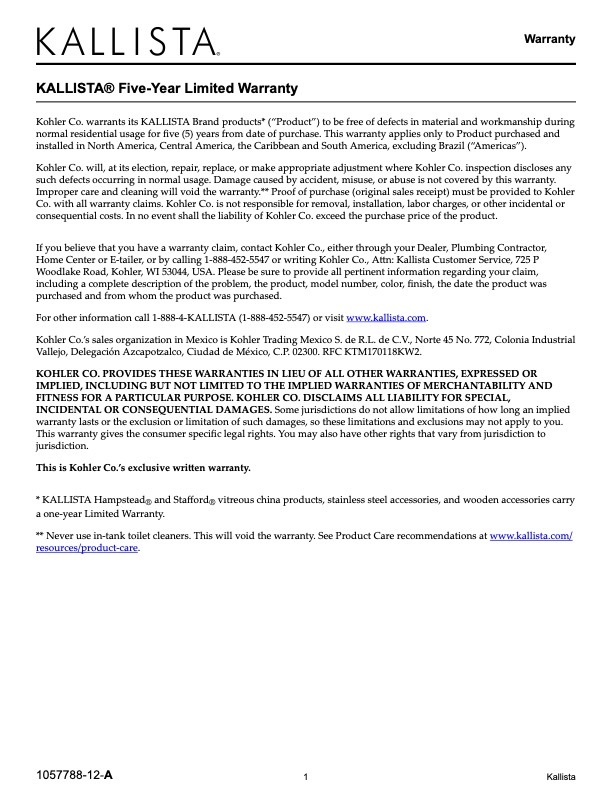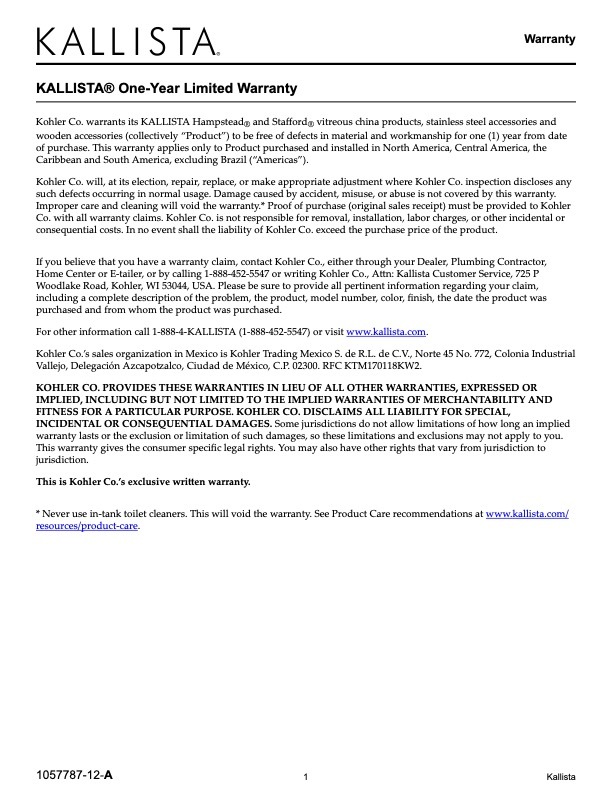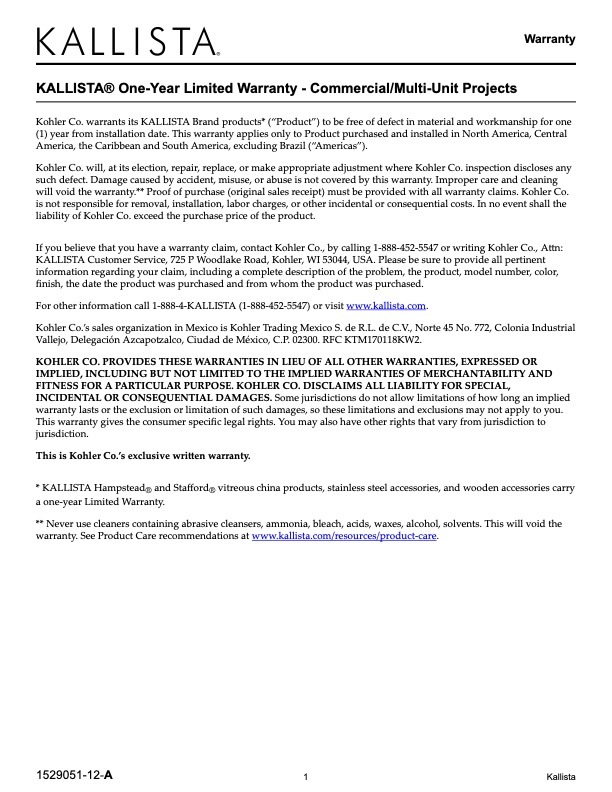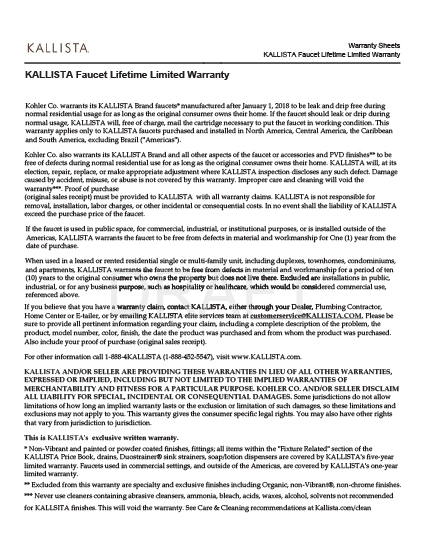Brochures
Sell Sheets
Warranty
Ready To Ship
KALLISTA is devoted to keeping a vast selection of sought-after bathroom and kitchen products in stock, ensuring they are ready for prompt delivery. Seek out the "In-Stock and Ready to Ship" icon and confidently choose from an extensive array of items for your upcoming renovation projects. Trust KALLISTA for timely, reliable service that aligns with your home improvement needs.
Our Ready-to-Ship program features expedited lead times on an assortment of faucets, fixtures, and rough-in items across various finishes and collections. On average, Ready-to-Ship products are dispatched within 3 days of order placement, and our knowledgeable sales associates stand by to assist customers in need of prompt delivery.
Please note that availability is subject to change.
For up-to-date lead times, kindly contact our customer service team at:
1-888-4KALLISTA or visit your local showroom.
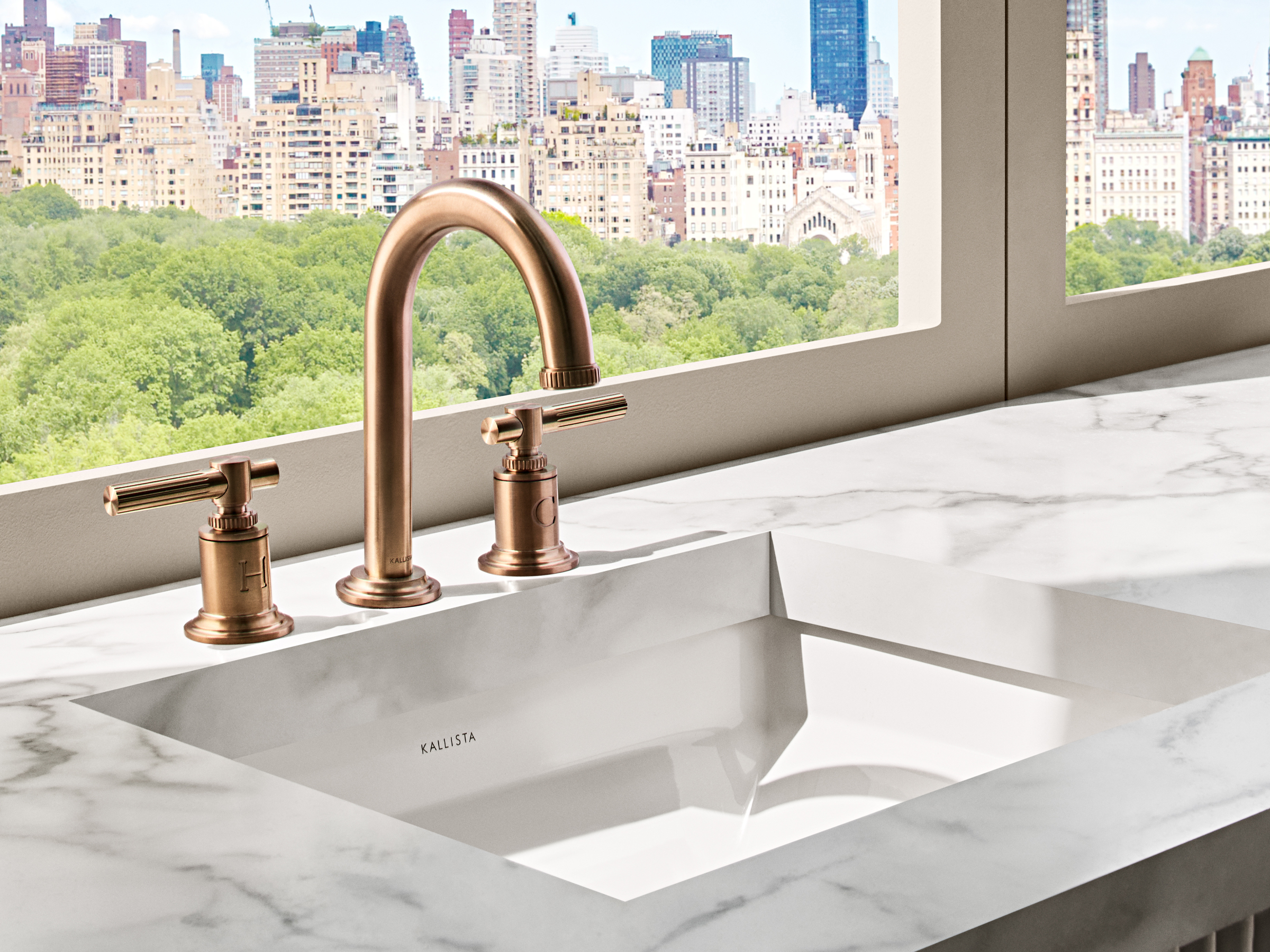
Kallista Showrooms
Experience the beauty of KALLISTA bathroom and kitchen products in person at a Kohler Signature Store showroom near you. Transform your next kitchen or bathroom remodel with genuine KALLISTA faucets, fixtures and fittings. Make an appointment to help turn your remodeling project dreams into reality.
Find A Showroom
Continuing Education
Accredited Course Offerings
KALLISTA is delighted to provide a wide range of continuing education courses that have been meticulously designed and curated to meet the exacting standards of various professional organizations. These courses have been accredited for Continuing Education Unit (CEU) certification, ensuring that professionals can enhance their knowledge and expertise while earning the necessary credits to maintain their professional certification. We take pride in offering top-quality education and training opportunities that enable professionals to stay up-to-date with the latest developments in their respective fields.
Custom Shower Solutions Course
While the bathroom was once a strictly utilitarian space, a growing trend among luxury consumers is to create a custom, spa-like wellness retreat right in the home. Surveys find that luxury consumers value functional and design excellence, uniqueness that reflects a creative side, and exceptional quality and value. This course examines the shower products available that help to create a personalized, multisensory wellness experience with beautifully designed pieces that meet water efficiency standards.
Self-care & Wellness Benefits Course
Traditionally, home has been a place for retreat and sanctuary. But as more people work from home, it is increasingly difficult to disengage from work responsibilities and set aside the time needed to refresh ourselves. As our stress levels rise, so does the need for self-care. This course looks at two areas of the home that are ideal for performing self-care and improving our well-being, assisted by investing in luxurious items: the bathroom and the kitchen.
FAQ
HOW DO I OBTAIN A KALLISTA CATALOG OR LITERATURE?
Please call 1-888-4-KALLISTA to request a catalog. Additionally, you can find current sell sheets in our Literature.
CAN I ORDER PRODUCTS DIRECTLY FROM KALLISTA?
We would be delighted to assist you in placing an order through one of our esteemed KALLISTA® Showrooms. Please allow us to guide you in finding a nearby location by visiting our "Find a Showroom" section, where we can connect you with our trusted partners.
CAN YOU TELL ME ABOUT MY CURRENT KALLISTA PRODUCT INSTALLED IN MY HOME?
We would be happy to review pictures of your product for identification, approximate date of production, as well as any other distinguishing facts regarding your piece. If you would like further information please, Contact Us.
CAN I ORDER REPLACEMENT HARDWARE?
Depending on the age of your piece and other factors, it may be possible to supply replacement hardware. Please visit our Contact Us page and send us further details.
HOW DO I CARE FOR MY KALLISTA PRODUCT?
Please visit our Product Care section to learn about the best methods to care for and clean your KALLISTA product.
WHERE CAN I SEE KALLISTA PRODUCTS IN PERSON?
We encourage you to experience the beauty of KALLISTA products in person at a showroom near you.
I SAW KALLISTA PRODUCTS IN A MAGAZINE THAT I LIKED. HOW CAN I FIND MORE INFORMATION?
Most of our press coverage can be found in our As Seen In section.
Please feel free to Contact Us. In your inquiry, please send the name of publication, month and page number of the magazine you would like additional information on and any descriptive details about the product. We will happily respond to your inquiry.
Other Questions?
We are here to assist you with any questions or concerns you may have. If you could not find the answers you were looking for in our comprehensive FAQ section, please do not hesitate to contact us. Our friendly and knowledgeable customer service team is standing by to provide you with the support you need. Simply reach out to us via our contact page, and we will get back to you as soon as possible. We appreciate your interest in Kallista and look forward to serving you!
Glossary
ACCESS PANEL
An opening in the wall or ceiling near the fixture that allows access for servicing the plumbing/electrical system.
ADA
Americans with Disabilities Act. Government criteria mandating how buildings must be constructed in order to serve the needs of people with disabilities.
BALL PASSAGE
Refers to the size of a ball that can pass through the trapway of a toilet. Standards are established based on minimum-sized ball passage. Ball passage also relates to trapway size. Generally speaking, the size of the trap will be 1/8 larger than the maximum-sized ball that can pass through it.
BALLCOCK
The mechanism that controls the flow of water into a gravity-operated toilet tank. The ballcock is controlled by the float mechanism floating in the water in the tank. When the toilet is flushed, the float drops and opens the ballcock, allowing water to enter the tank and/or bowl. The float rises as the water level in the tank is restored, and shuts off the ballcock when the tank is completely filled. Also referred to as a float valve.
BIDET
A personal hygiene fixture with hot and cold water supply installed near the toilet, so users can be refreshed after using the toilet.
BISQUE
Unglazed areas of vitreous china fixtures, such as inside the tank or on the bottom of the bowl foot, have a bisque finish.
BOWL
A water-containing receptor that receives liquid and solid body waste; two general bowl classifications are round-front and elongated.
CAST STONE
Cast Stone material has a thick gloss finish that is durable, easy to clean, scratch-resistant and can be simply repaired.
CLOSE-COUPLED
A toilet with a separate tank and bowl secured to each other. A separate tank cover is included. Also referred to as a two-piece toilet.
CLOSET BOLT
Two main anchor bolts that attach a toilet to the floor. Also known as toilet bolts or T-bolts. They slide into a channel on a toilet closet flange. After a toilet is moved into position, a nut threaded onto the bolt helps pull the toilet toward the closet flange and seat it into final position.
COMFORT-HEIGHT®
The height of a toilet bowl (with seat) that stands at the same height as a standard chair for maximum comfort and ease when sitting down or standing up.
COMPRESSION FITTING
An easy-to-use connector for copper or plastic pipe.
CONCEALED TRAPWAY
This feature provides a clean transition at the back of the toilet base, hiding the trapway for aesthetic and cleanability purposes.
CONSOLE TABLE
A table with ornamental legs and/or brackets that supports a bathroom countertop and lavatory.
CYCLE TIME
The time it takes from the instant a toilet flush lever is actuated until the instant the water supply shuts off completing the flush cycle.
DAM
The barrier built into the trapway of a toilet that controls the water level in the toilet bowl.
DECK-MOUNT
Term used to describe a faucet that is mounted on the deck of the bathtub enclosure, rather than on the rim of the bathtub or on the wall. Also referred to as a Roman spout faucet.
DIVERTER
Transfers water delivery between shower and bath faucets.
DIVERTER 3-WAY
Also known as a 3-way transfer valve. A valve which permits three outlets to be interconnected, allowing the user to redirect the water flow into any one outlet or a combination of two outlets.
DUAL RIM JET TECHNOLOGY
Exceptionally powerful flushing technology with two jets for outstanding bulk removal.
ELONGATED BOWL
A toilet bowl having dimensions of 14" wide x 18 1/2" long (from the center of the seat hinge holes to the front edge of the outside rim).
ENAMEL
A powder coating, usually a combination of clay, quartz, feldspar, silica and color pigments, applied to an iron casting. When exposed to high temperatures, the coating melts and fuses to the casting, creating a glass-like surface. The thickness of enamel provides outstanding protection against chipping and scratching while offering deep color integrity.
ESCUTCHEON
Any decorative, threaded flange below or behind a faucet handle. Also an ornamental plate used at the base of a faucet to cover additional holes on a lavatory or kitchen sink.
FACE PLATE
Trim piece found behind a single-control wall-mount faucet handle. Also known as a dial plate.
FIXTURE-MOUNT VACUUM BREAKER
An anti-siphon device that prevents waste water from being drawn back into supply lines and potentially contaminating the water supply; a type of backflow prevention.
FLAPPER
Also known as flush ball, the flapper is the moving part of the flush valve that seals the water into the tank or allows water to exit the tank for the flush cycle. This is the predominant replacement part used on conventional toilets.
FLEXIBLE CONNECTIONS
Connection between a valve body and T or supply stop that is bendable and makes installation easier. The opposite of a rigid connection.
FLOAT BALL
The float ball is connected to the ballcock inside the tank, which rises or falls with changing water levels in the tank, and actuates or shuts off the ballcock as needed.
FLOW RESTRICTOR
A device usually required by code to limit the maximum flow of water from an outlet. On devices with aerators, the aerator may perform the flow-restriction function. Other flow-restriction devices typically are not intended to be accessible or serviceable.
FLUSH VALVE
The valve located at the bottom of a gravity-operated toilet flush tank that opens when the trip lever is actuated and closes when the tank has drained to the desired level. It usually contains an overflow tube as well.
FLUSHING SURFACE
The interior surface of the bowl, as well as all other surfaces that may come into contact with the water during flushing.
GLAZE
A glossy, water-resistant, colored finish surface that protects all nonporous vitreous china plumbing fixtures.
GPF
An abbreviation for gallons per flush, a term used when discussing water consumption for toilets.
GPM
Volumetric flow rate in gallons per minute.
GRAVITY-FED TOILET
A toilet that relies on the natural downward pressure (or head) of water in a toilet tank to flush the toilet effectively.
IPS
Now referred to as NPT in most applications. IPS stand for Iron Pipe Size, although most pipe is no longer iron. Both NPT and IPS refer to a typical standard measure for threaded pipe with a tapered thread.
JET
Opening in toilet that directs water into the trapway to start siphon action.
LIVING FINISHES
A refined, handcrafted finish which will patina over time, making each piece as unique as the individual that touches it.
LOW-CONSUMPTION TOILET
A classification of toilet designed to flush using 1.6 or fewer gallons of water, as opposed to the outdated 3.5-gallon toilets and other higher-consumption toilets.
NPS
National Pipe Straight Threads Standard. NPS pipes are equipped with IPS threads and are only compatible with other NPS pipes.
NPT
National Pipe Tapered Threads Standard. NPT pipes are equipped with FIP and MIP threads, and are only compatible with other NPT pipes.
ONE-PIECE TOILET
A toilet in which the tank and bowl are manufactured as a single vitreous china fixture. Typically, one-piece toilets have a lower profile than two-piece toilets, although some feature a Comfort Height bowl.
OVERFLOW TUBE TOILET
The vertical tube inside a toilet tank (usually part of the flush valve) that directs water into the bowl in case the ballcock malfunctions. If the ballcock does not shut off properly, water will drain through the overflow tube into the bowl and flow harmlessly over the dam and out the drain. This prevents potential water damage caused by the tank overflowing and indicates to the user that there is a problem by a constant running condition. On most toilets, the overflow tube also has a refill tube flowing into it. The refill line directs water from the ballcock through the overflow tube to the bowl after the siphon break.
PEDESTAL LAVATORY
A stand-alone fixture with a lavatory resting atop a narrow base.
PIPE JOINT COMPOUND
A compound designed to provide a watertight seal in threaded connections. Also called pipe dope. Plumber's putty should not be used as a thread sealant.
PRESSURE-BALANCING VALVE
A shower mixing valve that automatically regulates fluctuations in hot and cold incoming water supplies. As a result the outlet temperature remains constant, though the outlet pressure may drop.
P-TRAP ASSEMBLY
P-shaped section of a drain pipe that traps water to prevent odors from escaping.
PUSH-BUTTON DIVERTER
A small button attached to the shower faucet that switches easily between shower and bath.
PVD
Physical Vapor Deposition (PVD) is a process that bonds the finish color to the faucet, helping it resist scratches, corrosion and tarnishing.
REFILL TUBE
On most toilets, a refill tube directs water from the ballcock into the overflow tube to refill the bowl after the siphon break.
RIM HOLES
A series of small holes in the underside of a toilet rim around the circumference of the bowl. Incoming water flows down into the bowl through these holes, creating a rinse effect orrim wash over the entire inner surface of the bowl.
ROUGH-IN DIMENSIONS
The distance from a finished wall or floor to the center of the waste or supply opening or mounting holes on a plumbing fixture.
ROUND-FRONT BOWL
A toilet bowl having dimensions of 14" wide x 16 ½" long (from the center of the seat hinge holes to the front edge of the outside rim).
SELF-RIMMING
Kitchen sink or lavatory with a finished rim that rests on the countertop.
SINGLE-CONTROL
Single-control faucets provide on/off activation and temperature setting with a single lever.
SINGLE-HOLE
One-hole drilling positioned in the center of a lavatory faucet ledge that provides for installation of a single-control faucet.
SIPHON BREAK
The point in a toilet flush when air is reintroduced into the trapway, breaking the siphonic action. The siphon break is usually heard as a deep gurgling at the conclusion of a flush.
SIPHON JET TOILET
A toilet having a siphonic trapway at the rear of the bowl and an integral flushing rim and jet.
SIPHONING
The suction or pulling effect that takes place in the trapway of a toilet as it is filled with outgoing water and waste. An effective siphon is critical to a successful flush for any toilet.
SUITE
A collection of products that share a similar design theme, usually comprised of the following components: a bath/whirlpool, lavatory and toilet.
SUPPLY STOP
The valve that provides on/off toilet water supply control.
TANK
The fixture reservoir for flushing water. On a conventional toilet, the ballcock, flush valve and trip lever are installed in the tank. A tank lid closes the top tank opening.
THERMOSTATIC VALVE
A pressure-balancing shower valve with automatic temperature control. When temperature or pressure fluctuations occur at the water inlets, a thermal actuator adjusts the hot and cold ratio to maintain the original temperature setting; this allows the user to set and maintain a consistent temperature.
TOWER DRAIN
Freestanding tub drain with a built-in internal stopper and gravity-activated overflow.
TRANSFER VALVE
A valve within a showering product that transfers the water from one port to another.
TRAPWAY
The channel in a toilet that connects the bowl to the waste outlet. The trapway is where siphonic action takes place, and it's measured in terms of the largest diameter ball that can pass through it. Also referred to as passageway.
TRAPWAY SEAL
The height of water in a toilet bowl at rest, it provides a water seal that prevents sewer gases from entering the home. The trapway seal is measured from the top of the dam to the inlet of the trapway. Also referred to as deep seal.
TRIM
Any non-vitreous china toilet components, with the exception of the seat. Examples include the ballcock, bolt caps and trip lever.
TRIP LEVER
A lever that is rotated to initiate the toilet flush cycle. Factory-installed trip levers have a Polished Chrome finish; optional trim kits offer trip levers in other finishes.
TWO-HANDLE
Two-handle faucets feature separate handles to control hot and cold water temperature.
TWO-PIECE TOILET
A toilet with a separate tank and bowl. Also referred to as close-coupled.
TWO-WAY DIVERTER VALVE
Transfers water delivery between two shower or bath faucet components.
ULF
Ultra-Low Flush (ULF) is a widely used descriptor for low-consumption toilets that use 1.6 gallons of water or fewer per flush.
UNDERCOUNTER
Style of kitchen sink or lavatory that installs beneath the counter top for a contemporary, clean look.
UNIVERSAL DESIGN
Universal design should be invisible and, at the same time, accommodate a wide variety of people of all ages and statures. It allows access to a richer life by eliminating disability by design. This thoughtful approach to space and barriers allows the maximum number of people to use the widest variety of products in their homes for the greatest length of time.
VACUUM BREAKER
An anti-siphon device which prevents the backflow of non-potable water into the water supply system.
VANITY
Bathroom cabinet that supports a countertop and lavatory.
VITREOUS CHINA
A term applied to plumbing fixtures that are comprised of ceramic materials, fired at a high temperature to form a nonporous body with exposed surfaces, and coated with ceramic glaze fused to the body.
WASHDOWN TOILET
A toilet having a siphon trapway at the front of the bowl and an integral flushing rim. Minimum dimensions are 8" x 7" water spot and a 1 ½” ball passage.
WATER CLOSET
A plumbing fixture having a water-containing receptor that receives liquid and solid body waste and, upon actuation (flushing), conveys the waste through a trapway into a gravity drainage system.
WATER SAVING SIPHON JET TECHNOLOGY
A flushing technology designed to create extraordinary flushing performance with an industry-leading 3 ½” flush valve. Water saving siphon jet technology provides powerful water flow to maximize the gravity-fed flush and features simplified installation and an eco-friendly 1.4-gallon flush setting option.
WATER-SAVING TOILET
A classification of toilet that uses no more than 1.6 gallons per flush.
WATER SPOT
The water surface in the toilet bowl once the flush is completed. This is established by the height of the integral trapway dam. Usually expressed in inches of width by length. Also referred to as water surface.
WIDESPREAD LAVATORY FAUCET
A faucet with hot and cold handles separate from the spout, usually in an 8" setting, measured from left handle to right handle.
Product Care
Cleaning Chrome (CP) and Nickel Silver (AD)
Care of Brushed Nickel (AG), Gunmetal (GN), and Matte Black (BL) products
Care of Unlacquered Brass (ULB)
Cleaning Chrome (CP) and Nickel Silver (AD)
Water conditions vary across the country. Chemicals and minerals in water and air can combine to have an adverse effect on the finish of your products. In addition, nickel silver shares similar characteristics and appearance with sterling silver, and slight tarnishing is normal.
We recommend that you rinse away any traces of soap and gently dry with a clean, soft cloth after each use. This care will maintain the high-gloss finish of your KALLISTA® product and avoid water spotting.
An occasional application of a pure, nonabrasive wax is helpful in preventing water spot buildup and light buffing with a soft cloth will produce a high luster.
To remove water spots and tarnishing, apply a small amount of Simichrome Polish™ to the fixture; rub briskly; wipe clean with a clean, soft cloth. Simichrome also contains a protective film to enhance maintenance.
NOTE: DO NOT USE ABRASIVE CLEANERS OR SOLVENTS
NOTE: FOR MIXED-FINISH PRODUCTS, USE THE APPROPRIATE CLEANING INSTRUCTIONS FOR THE COMPONENT FINISH
Care of Brushed Nickel (AG), Gunmetal (GN), and Matte Black (BL) products
While KALLISTA luxury finishes plate to a greater thickness and higher quality than usual, they are still jewelry finishes and require special maintenance.
Water conditions vary across the country. Chemicals and minerals in water and air can combine to have an adverse effect on the finish of your products.
Rinse away any traces of soap and gently dry with a clean, soft cloth after each use. This care will maintain the high-gloss finish of your KALLISTA products and avoid water spotting. These finishes are not recommended for outdoor application.
An occasional application of a pure, nonabrasive wax is helpful in preventing water spot buildup, and light buffing with a soft cloth will produce a high luster. Do not allow materials such as toothpaste, nail polish remover or caustic drain cleaners to remain on the surface.
Over time, with constant cleaning, the surface of your product may begin to show wear. The wear will take the form of faint lines in the highly polished surface.
NOTE: MATTE BLACK, OR OTHER POWDER COATS, SHOULD BE CLEANED WITH A SOFT DAMP CLOTH USING MILD DISH SOAP OR A 50/50 WATER AND VINEGAR SOLUTION
NOTE: DO NOT USE ABRASIVE CLEANERS OR SOLVENTS
NOTE: FOR MIXED-FINISH PRODUCTS, USE THE APPROPRIATE CLEANING INSTRUCTIONS FOR THE COMPONENT FINISH
Care of Unlacquered Brass (ULB)
Brass will naturally tarnish or age quickly after little exposure to its environment, creating a beautiful brown or gray-green color.
Rinse away any traces of soap and gently dry with a clean, soft cloth after each use. Brass polishing compound applied with a soft cloth will remove the patina and restore the brass to its original shine.
Water conditions vary across the country. Chemicals and minerals in water and air can combine to have an adverse effect on the finish of your products. These finishes are not recommended for outdoor application.
NOTE: DO NOT USE ABRASIVE CLEANERS OR SOLVENTS
NOTE: FOR MIXED-FINISH PRODUCTS, USE THE APPROPRIATE CLEANING INSTRUCTIONS FOR THE COMPONENT FINISH
Care of PVD Finishes: Polished Nickel (SN), Brushed Bronze (BV), French Gold (AF), Stainless (VS), Brushed Moderne Brass (2MB) and Brushed Nickel (BN)
Do not use cleaners containing ammonia, bleach or acid. Rinse thoroughly and use a soft cloth to wipe the product dry after each use.
Success with cleaners and procedures is dependent upon such factors as the hardness and temperature of the water, using exact measurements of ingredients, changes in cleaning formulas and the condition of the product being cleaned. Since there are variations within factors, KALLISTA cannot guarantee the effectiveness of the formulas mentioned.
Ideal cleaning technique is to always blot dry any water from metal surfaces. Allowing water to evaporate on metal will form water deposits. It is important to use a dabbing action to dry metal, not an abrasive or rubbing action. Cleaning with a damp sponge and buff drying should keep your product looking beautiful.
Products to consider:
• Fantastik® Antibacterial Heavy Duty
• Green® Works All-Purpose
• Green Works Glass Cleaner
• Windex® Ammonia-Free
Care of Acrylic, Cast Mineral or Cast Stone Products
Cleaning Your Acrylic, Cast Mineral or Cast Stone Products
Do not use abrasive cleansers or solvents on acrylic surfaces. Wipe out acrylic, cast mineral or cast stone bath or sink with a soft cloth after each use. Avoid detergents, disinfectants or cleaning products in aerosol cans. If the surface becomes excessively dirty, use a general-purpose cleaner such as:
• Formula 409® All Purpose Cleaner
• Gel Gloss® (Bath and Shower only)
• Scrub Free® Mildew Stain Remover
• Mr. Clean® Lemon Fresh
• Cinch®
• Glass Plus®
• Fantastik® All Purpose
NOTE: TO RESTORE DULL OR SCRATCHED UNITS, APPLY WHITE AUTOMOTIVE POLISHING COMPOUND WITH A CLEAN RAG. RUB SCRATCHES AND DULL AREAS VIGOROUSLY. WIPE OFF RESIDUE. FOLLOW WITH A COAT OF WHITE AUTOMOTIVE PASTE WAX. DO NOT WAX AREAS WHERE YOU WALK OR STAND.
Use a soft cloth to wipe the keypad and remote control after each use. If the surface becomes dirty, use a nonabrasive soap and warm water to clean.
Care of Acrylic Baths with Airjets
Cleaning Your Acrylic Bath with Airjets
Do not use powdered cleaners unless the cleaner is fully dissolved in water. Solid substances could block the airjets.
Do not use full-strength bleach or ammonia cleaning solutions. Chemically active cleaning solutions can damage the bath surface.
Do not use abrasive cleansers or solvents on acrylic surfaces. Abrasive cleaners and solvents can damage the bath surface.
Wipe out acrylic bath with a soft cloth after each use.
Avoid detergents, disinfectants or cleaning products in aerosol cans.
If the surface becomes excessively dirty, use a general-purpose cleaner such as:
• Formula 409, All Purpose Cleaner
• Gel Gloss (Bath and Shower only)
• Scrub Free, Mildew Stain Remover
• Mr. Clean, Lemon Fresh
• Cinch
• Glass Plus
• Fantastik® All Purpose
NOTE: TO RESTORE DULL OR SCRATCHED UNITS, APPLY WHITE AUTOMOTIVE POLISHING COMPOUND WITH A CLEAN RAG. RUB SCRATCHES AND DULL AREAS VIGOROUSLY. WIPE OFF RESIDUE. FOLLOW WITH A COAT OF WHITE AUTOMOTIVE PASTE WAX.
DO NOT WAX AREAS WHERE YOU WALK OR STAND.
Cleaning Your User Keypad and Remote Control
Use a soft cloth to wipe the keypad and remote control after each use. If the surface becomes dirty, use a nonabrasive soap and warm water to clean.
Maintaining the Airjets
If cleaning the airjets is required due to hard water deposits, use a small between-the-teeth dental brush and white vinegar. Dip the brush in the vinegar, brush the hole, rinse the brush in clean water and use the wet rinsed brush to rinse the hole.
Fill the bath with water to the top row of airjets. Drain the bath and press the purge button.
Flushing Your Air Bath System
Flush your air bath system twice a month or more, depending upon usage. Use the following sequence:
1. Fill bath with water 1" (2.5 cm) above the top of all airjets.
2. While bath is filling, carefully add 1 cup of bleach to the water.
3. Let sit for 10- 15 minutes.
4. Drain the water, run the purge cycle and rinse any debris from the bath.
5. Clean bath surfaces as needed with recommended cleaners.
6. Dry the bath with a clean, soft towel.



